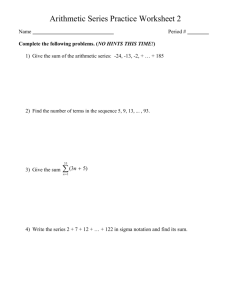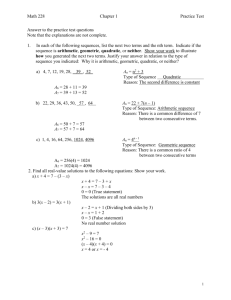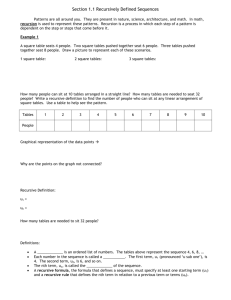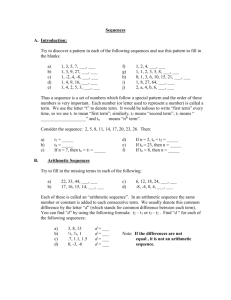chapter-9-solutions
advertisement
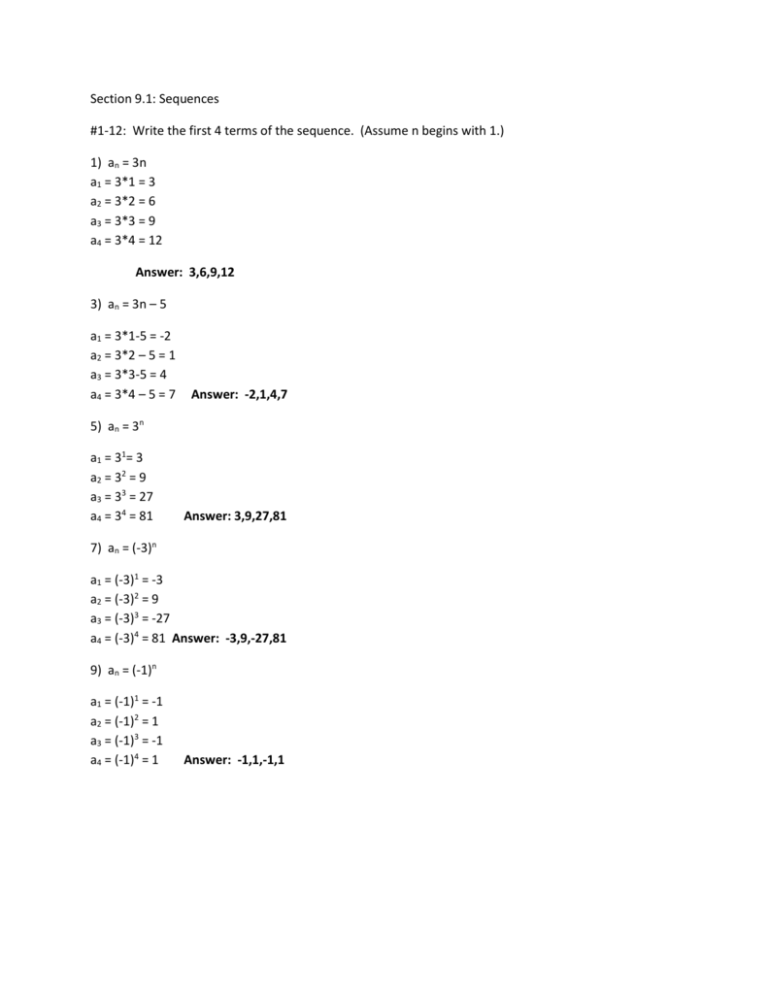
Section 9.1: Sequences #1-12: Write the first 4 terms of the sequence. (Assume n begins with 1.) 1) an = 3n a1 = 3*1 = 3 a2 = 3*2 = 6 a3 = 3*3 = 9 a4 = 3*4 = 12 Answer: 3,6,9,12 3) an = 3n – 5 a1 = 3*1-5 = -2 a2 = 3*2 – 5 = 1 a3 = 3*3-5 = 4 a4 = 3*4 – 5 = 7 Answer: -2,1,4,7 5) an = 3n a1 = 31= 3 a2 = 32 = 9 a3 = 33 = 27 a4 = 34 = 81 Answer: 3,9,27,81 7) an = (-3)n a1 = (-3)1 = -3 a2 = (-3)2 = 9 a3 = (-3)3 = -27 a4 = (-3)4 = 81 Answer: -3,9,-27,81 9) an = (-1)n a1 = (-1)1 = -1 a2 = (-1)2 = 1 a3 = (-1)3 = -1 a4 = (-1)4 = 1 Answer: -1,1,-1,1 Section 9.1: Sequences 11) an = a1 = a2 = a3 = a4 = (−1)𝑛+1 2𝑛 (−1)1+1 1 = 2∗1 2 (−1)2+1 −1 = 4 2∗2 (−1)3+1 1 = 2∗3 6 (−1)4+1 −1 = 8 2∗4 Answer: 𝟏 −𝟏 𝟏 −𝟏 , , , 𝟐 𝟒 𝟔 𝟖 #13-24: Find the indicated term 13) an = 3n; a8 Answer: a8 = 3*8 = 24 15) an = 3n – 5; a16 Answer: a16 = 3*16-5 = 43 17) an = 3n; a5 Answer: a5 = 35 = 243 19) an = (-3)n; a6 Answer: a6 = (-3)6 = 729 21) an = (-1)n; a50 Answer: a50 = (-1)50 = 1 23) an = (−1)𝑛+1 2𝑛 Answer: 𝒂𝟏𝟐 = ; a12 (−𝟏)𝟏𝟐+𝟏 𝟐∗𝟏𝟐 = −𝟏 𝟐𝟒 #25-40: write an expression for the nth term of the sequence 25) 2,4,6,8,10…. Answer: an = 2n Section 9.1: Sequences 27) 3,5,7,9,11,13…. I know I need a 2n since each term is 2 apart. Solve 2(1) – x = 3 to figure out the number that goes after the 2n. Answer: an = 2n+1 29) -3, -1, 1, 3,5… Each term is 2 apart, so again I need a 2n Solve 2(1) – x = -3 to figure out what to write after the 2n Answer: an = 2n - 5 31) 6,10,14,18,22… Each term is 4 apart, so I need a 4n. Solve 4(1) + x = 6 to figure out what number goes after the 4n. Answer: an = 4n + 2 33) 7,13,19,25… Each term is 6 apart, so I need a 6n. Solve 6(1) + x = 7 to figure out what number goes after the 6n. Answer: an = 6n +1 35) 2,4,8,16,32… I have to multiply by 2 to get from one number to the next. Since the first number is 2 the formula, there isn’t any algebra needed to find a number to put in front of the 2. Answer: an = 2n Section 9.1: Sequences 37) 6,12,24,48… Each number is a multiple of 2 apart. I need a 2n in the formula. I will need a number in front of the 2n to get the correct answer. I find the number by solving x(21) = 6 x=3 Answer: an = 3(2n) 39) 1,2,4,8,16… Each number is a multiple of 2 apart. I need a 2n in the formula. I will need a number in front of the 2n to get the correct answer. I find the number by solving x(21) = 1 x = 1/2 𝟏 Answer: an = 𝟐(2n) it would also be correct to write 2n-1 #41-48: Write the first 3 terms of the recursively defined sequence. 41) a1 = 6, ak+1 = ak + 3 a2 = a1 + 3 a2 = 6 + 3 a2 = 9 a3 = a2 + 3 a3 = 9 + 3 a3 = 12 Answer: first 3 terms 6,9,12 Section 9.1: Sequences 43) a1 = 6, ak+1 = 2(ak – 1) a2 = 2(a1 – 1) a2 = 2(6-1) a2 = 10 a3 = 2(a2 – 1) a3 = 2(10-1) a3 = 18 Answer: first three terms are 6,10,18 45) a1 = -3, ak+1 = 2ak + 3 a2 = 2a1 + 3 a2 = 2*(-3) + 3 a2 = -3 a3 = 2a2 + 3 a3 = 2(-3) + 3 a3 = -3 Answer: first three terms -3,-3,-3 1 47) a1 = 6, ak+1 = 2ak + 4 1 𝑎2 = 2 𝑎1 + 4 1 2 𝑎2 = ∗ 6 + 4 a2 = 7 1 𝑎3 = 2 𝑎2 + 4 1 2 𝑎3 = ∗ 7 + 4 𝑎3 = 15 2 Answer: First three terms 6,7, 𝟏𝟓 𝟐 Section 9.1 sequences #49-56: find the indicated sum 49) ∑4𝑘=1 2𝑘 = 2*1 + 2*2 + 2*3 + 2*4 =2+4+6+8 Answer: 20 6 51) ∑(2𝑘 − 3) 𝑘=2 = (2*2 -3) + (2*3 – 3) + (2*4 – 3) + (2*5 – 3) = 1+3+5+7 Answer: 16 4 53) ∑ 2𝑘 𝑘=0 = 20 + 21 + 22 + 23 + 24 = 1 + 2 + 4 +8 + 16 Answer: 31 8 55) ∑(−1)𝑘 𝑘=4 = (-1)4 + (-1)5 + (-1)6 + (-1)7+(-1)8 = 1 + (-1) + 1 + (-1) + 1 Answer: 1 2 57) ∑3𝑘=1 𝑘 2 2 2 =1+2+3 Answer: 𝟏𝟏 𝟑 Section 9.1 sequences 6 59) ∑ 5 𝑘=1 =5+5+5+5+5+5+5 Answer: 30 Section 9.2: Arithmetic sequences: #1-8: show that each sequence is arithmetic. Find the common difference and write out the first 4 terms. 1) an = 3n + 5 a1 = 3(1) + 5 = 8 a2 = 3(2) + 5 = 11 a3 = 3(3) + 5 = 14 a4 = 3(4) + 5 = 17 Answer: common difference = 3 first 4 terms; 8,11,14,17 3) an = 5n - 2 a1 = 5(1) – 2 = 3 a2 = 5(2) – 2 = 8 a3 = 5(3) – 2 = 13 a4 = 5(4) – 2 = 18 Answer: common difference = 5 first 4 terms; 3,8,13,18 5) an = 3 – 4n a1 = 3-4(1) = -1 a2 = 3 – 4(2) = -5 a3 = 3 – 4(3) = -9 a4 = 3- 4(4) = -16 Answer: common difference = -4 first 4 terms; -1,-5,-9,-16 Section 9.2: Arithmetic sequences: 7) an = 4 – 6n a1 = 4 – 6(1) = -2 a2 = 4 – 6(2)= -8 a3 = 4 – 6(3) = -14 a4 = 4 – 6(4) = -20 Answer: common difference = -6 first 4 terms; -2,-8,-14,-20 #9-18: Find a formula for the nth term of the arithmetic sequence with initial term a1 and common difference d. 9) a1 = 4; d = 3 I know I need a 3n for the common difference to be 3. I just need to solve for the number after the 3n. an = 3n+x a1= 3(1) +x 4=3+x 1=x Answer: an = 3n+1 11) a1 = -2; d = 1 I need a 1n, for the common difference of 1. I need to solve for the number after the 1n. an = 1n+x a1 = 1(1) + x -2 = 1 + x -3 = x Answer: an = 1n – 3 or just n - 3 Section 9.2: Arithmetic sequences: 13) a1 = 4; d = -3 I need a -3n, for the common difference of -3. I need to solve for the number after the -3n. an = -3n+x a1 = -3(1) + x 4 = -3 + x 7=x Answer: an = -3n + 7 15) a1 = -2; d = -1 I need a -1n, for the common difference of -1. I need to solve for the number after the -1n. an = -1n+x a1 = -1(1) + x -2 = -1 + x -1 = x Answer: an = -1n – 1 or just -n - 1 #17-24: Find the indicated term in each arithmetic sequence. 17) 50th term of, 3,6,9,12… First I need a formula for an; an = 3n + x a1 = 3(1) +x 3=3+x 0=x Formula for sequence: an = 3n computation of 50th term: a50 = 3(50) = 150 Answer: 150 Section 9.2: Arithmetic sequences: 19) 100th term of 5, 8, 11, 14… First I need a formula for an: an = 3n + x a1 = 3(1) +x 5=3+x 2=x Formula for sequence: an = 3n +2 computation of 100th term: a100 = 3(100)+2 = 302 Answer: 302 21) 80th term of 5,2,-1,-4… First I need a formula for an: an = -3n + x a1 = -3(1) +x 5 = -3 + x 8=x Formula for sequence: an = -3n + 8 computation of 80th term: a80 = -3(80)+8 = -232 Answer: -232 23) 25th term of 20, 18,16,14… First I need a formula for an: an = -2n + x a1 = -2(1) +x 20 = -2 + x 22 = x Formula for sequence: an = -2n +22 computation of 25th term: a25 = -2(25)+22 Answer: -28 Section 9.2: Arithmetic sequences: 25) A local theater has 30 seats in the first row and 50 rows in all. Each successive row contains two additional seats. How many seats are in the 50th row of the theater? This is just a arithmetic sequence problem with a1 = 30, and d = 2. I need to find a50. First I will get a formula for an an = 2n+x a1 = 2(1) + x 30 = 2 + x 28 = x Formula for sequence: an = 2n+28 now to find the number of seats in the 50th row: a50 = 2(50) + 28 = 128 Answer: There are 128 seats in the 50th row. 27) An outdoor amphitheater has 40 seats in the first row, 41 seats in the second row, 42 seats in the third row. The pattern continues. The amphitheater has 40 rows. How many seats are in the 30th row of the theater? This is just a arithmetic sequence problem with a1 = 40, and d = 1. I need to find a40. First I will get a formula for an an = 1n+x a1 = 1(1) + x 40 = 1 + x 39 = x Formula for sequence: an = n+39 now to find the number of seats in the 40th row: a40 = 40+39 = 79 Answer: There are 79 seats in the 40th row. Section 9.2: Arithmetic sequences: #29 – 40 Find the indicated sum 40 29) ∑ 2𝑘 𝑘=1 I can write out the problem without summation notation as follows; 2(1) + 2(2) + 2(3) +….+ 2(40) 2 + 4 + 6+ …. + 80 This is asking me to add the first 40 terms of an arithmetic sequence. I will use the formula 𝑛 Sn = 2 (a1 + an) In this case: S40 = 40 (2 2 + 80)=20(82)=1640 Answer: 1640 60 31) ∑(2𝑘 − 3) 𝑘=1 I can write out the problem without summation notation as follows; (2*1-3) + (2*2-3) + (2*3 – 3) +….+ (2*60-3) -1+ 1 + 3+ …. + 117 This is asking me to add the first 60 terms of an arithmetic sequence. I will use the formula 𝑛 Sn = 2 (a1 + an) In this case: S60 = Answer: 3480 60 (−1 + 2 117)=30(116)=3480 Section 9.2: Arithmetic sequences: 40 33) ∑(5 − 2𝑘) 𝑘=1 I can write out the problem without summation notation as follows; (5-2*1) + (5-2*2) + (5-2*3) +….+ (5-2*40) 3+ 1 + (-1)+ …. + (-75) This is asking me to add the first 40 terms of an arithmetic sequence. I will use the formula 𝑛 Sn = 2 (a1 + an) In this case: S40 = 40 (3 2 + (−75))=20(-72)= -1440 Answer: -1440 20 35) ∑(60 − 5𝑘 ) 𝑘=1 I can write out the problem without summation notation as follows; (60-5*1) + (60-5*2) + (60-5*3) +….+ (60-5*20) 55+ 50 + 45+ …. + (-40) This is asking me to add the first 20 terms of an arithmetic sequence. I will use the formula 𝑛 Sn = 2 (a1 + an) In this case: S20 = Answer: 150 20 (55 + 2 (−40))=10(15)=150 Section 9.2: Arithmetic sequences: 37) A local theater has 30 seats in the first row and 50 rows in all. Each successive row contains two additional seats. How many seats are in the theater? I need to know how many seats are in the 50th row. I will find a formula for an to get started. an = 2n + x a1 = 2(1) + x 30 = 2 + x 28 = x formula for sequence: an = 2n + 28 computation of number of seats in 50th row: a50 = 2(50) + 28 = 128 I need to add these numbers to get my answer: 30 + 32 + 34+…..+ 128 𝑛 2 I will use the formula Sn = (a1 + an) S50 = 50 (30 + 2 128) = 25(158) = 3950 Answer: There are 3950 seats. 39) An outdoor amphitheater has 40 seats in the first row, 41 seats in the second row, 42 seats in the third row. The pattern continues. The amphitheater has 70 rows. How many seats does the amphitheater contain? I need to know how many seats are in the 70th row. I will find a formula for an to get started. an = 1n + x a1 = 1(1) + x 40 = 1 + x 39 = x formula for sequence: an = n + 39 computation of number of seats in 70th row: a70 = 70 + 39 = 109 I need to add these numbers to get my answer: 40 + 41 + 42+…..+ 109 𝑛 2 I will use the formula Sn = (a1 + an) S50 = 70 (40 + 2 109) = 35(149) = 5215 Answer: There are 5215 seats Section 9.3: Geometric Sequences and Series: #1-10: List the first 4 terms of the geometric series and find the common ratio (r). 1) an = 2n a1 = 21 = 2 a2 = 22 = 4 a3 = 23 = 8 a4 = 24 = 16 Each term is a multiple of 2 apart so the common ratio is 2. Answer: First 4 terms 2,4,8,16 common ratio 2 3) an = 3(2n) a1 = 3(21) = 6 a2 = 3(22) = 12 a3 =3( 23) = 24 a4 = 3(24) = 48 Each term is a multiple of 2 apart so the common ratio is 2. Answer: First 4 terms 6,12,24,48 common ratio 2 1 𝑛 5) an = (2) 1 1 1 1 2 2 1 3 1 4 1 4 2 1 16 𝑎1 = (2) = 2 𝑎2 = ( ) = 1 𝑎3 = (2) = 8 𝑎4 = ( ) = 1 Each term is a multiple of ½ apart so the common ratio is 2 𝟏 𝟏 𝟏 𝟏 Answer: first 4 terms 𝟐 , 𝟒 , 𝟖 , 𝟏𝟔 common ratio ½ Section 9.3: Geometric Sequences and Series: 7) an=23n a1 = 23*1 = 8 a2 = 23*2 = 64 a3 = 23*3 = 512 a4 = 23*4 = 4096 Each term is a multiple of 8 apart so the common ratio is 8. Answer: first 4 terms 8,64,512,4096 common ratio 8 9) an = 2(32n) a1 = 2(32*1) = 18 a2 = 2(32*2) = 162 a3 = 2(32*3) = 1458 a4 = 2(32*4) = 13122 Each term is a multiple of 9 apart so the common ratio is 9. Answer: first 4 terms 18,162,1458,13122 common ratio 9 #11-18: Find a formula for the nth term of the geometric sequence with first term a1 and common ratio (r). 11) a1 = 2; r = 3 an = x(3n) a1 = x(31) 2 = 3x 2 3 =𝑥 𝟐 Answer: an = 𝟑 (𝟑𝒏 ) 13) a1 = 6; r = 2 an = x(2n) a1 = x(21) 6 = 2x 3=x Answer: an = 3(2n) Section 9.3: Geometric Sequences and Series: 1 15) a1 = 1; r = 2 1 𝑛 an = 𝑥 (2) 1 1 1 = 𝑥 (2) 1 1 = 2𝑥 1 2*1 = 2*2 𝑥 2=x 𝟏 𝒏 𝟐 Answer: an = 𝟐 ( ) or 21-n 17) a1 = 4; r = 1 2 1 𝑛 2 1 1 an = x( ) a1 = x(2) 1 4 = 2𝑥 1 2*4 = 2*2 𝑥 8=x 𝟏 𝒏 Answer: an = 8(𝟐) 𝒐𝒓 𝟐𝟑−𝒏 #19-26: Find the indicated term of the geometric sequence 19) The 10th term; 6,18,54,162,… First develop a formula for an; first term is 6 and common ratio is 3 an = x(3n) a1 = x(31) 6 = x(31) 2=x formula for an = 2(3n) Now find the 10th term: a10 = 2(310) = 118098 Answer: 118098 Section 9.3: Geometric Sequences and Series: 21) The 9th term; 5,20,80,160… First develop a formula for an; first term is 5 and common ratio is 4 an = x(4n) a1 = x(41) 5 = 4x 5 = 4 x 5 formula for an = 4 (4𝑛 ) 5 Now find the 9th term: a9 = 4 (49 ) = 327680 Answer: 327680 23) The 14th term; 200,100,50,25… First develop a formula for an; first term 200, common ratio ½ 1 𝑛 an = x(2) 1 1 2 200 = x( ) 1 2 200 = 𝑥 1 2*200 = 2*2 𝑥 400 = x 1 𝑛 formula for an = 400(2) 1 14 now find the 14th term: a14 = 400(2) Answer: 𝟐𝟓 𝟏𝟎𝟐𝟒 25 = 1024 Section 9.3: Geometric Sequences and Series: 25) The 20th term; 39366, 13122, 4374,… 1 First develop a formula for an; first term 39366 common ratio 3 1 𝑛 an = x(3) 1 1 39366 = x(3) 1 3 39366 = 𝑥 1 3*39366 = 3*3 𝑥 118098 = x 1 𝑛 an = 118098(3) 1 20 2 now I can find a20 = 118098(3) = 59049 Answer: 𝟐 𝟓𝟗𝟎𝟒𝟗 27) Jess currently has a salary of $40,000 per year. She expects to get an annual raise of 2%. What will her salary be when she begins her 10th year? First term of sequence 40,000 common ratio 1.02 formula for an = 40000(1+02)n a10=40000(1.02)10 = 48759.78 Answer: $48,759.78 29) The price of the average Phoenix home is $135,000. The price is expected to increase by 2.5% per year. What will the average price of a Phoenix home be in 8 years? an = 135000(1+025)n a8 = 135000(1.025)8 = 164484.39 Answer: $164484.39
